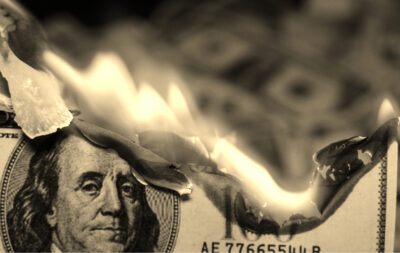The end of cash?
Follow the money…
Why are we still using cash? Given the rapid advances we’ve enjoyed in digital payment technology thanks to debit and credit cards and apps like PayPal, Apple Pay and Venmo, many economists are puzzled that cash hasn’t already begun going the way of the dodo. But what’s even more puzzling – and what the latest episode of Freakonomics delves into – is the fact that despite these major FinTech (“financial technology”) advances there are actually more dollars floating around in circulation today in real terms than ever before.
According to the Federal Reserve (Fed), in the mid-1970s, there was roughly $80 billion of U.S. currency floating around the global economy. By the mid-2000s, that number had skyrocket by nearly 2,000 percent to nearly $1.5 trillion. More puzzling is the fact that there has also been a massive shift in the composition of the bills that comprise that total. In 1976, $100 bills – the largest denomination bill available – comprised less than 25 percent of the currency in circulation. Today, these large bills account for roughly 80 percent of the outstanding bills in circulation, a more than 300 percent rise since 1976.
What can possibly explain this phenomenon? To their credit, the two economists interviewed in the episode – Harvard’s Kenneth Rogoff and Yale’s James S. Henry – identify the primary factor: black market activity.
As William Luther notes in US News and World Report, “More than half of the currency in most countries is used to hide transactions from tax or law enforcement authorities. Back-of-the-envelope calculations suggest that could be a conservative estimate for the dollar.”
But then why do the mafia-hired butcher (i.e. assassin), weed brownie baker, and crack pipe maker all prefer Federal Reserve notes to debit cards, bitcoin, or even gold? The economic rationale is straightforward. No payment technology is as widely accepted, easy to transport, and as anonymous as cash. Put yourself in Walter White’s shoes from the hit AMC series Breaking Bad and you’ll realize that it’s far easier to ship crates full of $100s than entire boatloads full of small denomination notes to keep your international meth empire afloat. One of the most powerful pieces of evidence is that the vast majority of $100 bills in circulation today (roughly three-quarters, Henry estimates) reside in border cities that serve as drug trafficking hotspots such as Los Angeles, El Paso, and Miami.
Unearthing the underground: the battle between public welfare and public choice
What’s the best way to unearth this multi-billion dollar underground economy? One solution that has gained traction is to cut off its very lifeblood: cash.
Why aren’t the feds chomping at the bit to cut off the cash pipeline to the underground economy? The most sinister yet accurate explanation is the one offered by Rogoff: the feds and the Fed are hesitant to put down the cash pipe because they enjoy an enormous fiscal high from being the preferred cash dealer of the global black market.
Black markets matter for central banks precisely because they form such a large slice of global economic activity. According to research conducted by economists Ceyhun Elgin and Oguz Oztunali, the size of the black market globally is roughly 25 percent of world GDP, or roughly $28 trillion in 2014 dollars. Since the U.S. dollar remains the most trusted and recognized currency, it is the top choice for global criminal syndicates.
Black markets also produce ideal clientele for central bankers. Due to their keen desire not to be detected, they are less likely to quickly spend currency into circulation. Even once their money has been laundered, much of it remains in the underground economy and hence out of circulation. It is for this reason that Rogoff refers to the Federal Reserve’s quiet duplicity with the criminal underground as “reverse money laundering.”
Why does this low velocity (i.e. high demand to hold rather than spend cash) of cash in the underground economy serve the interest of both the Fed and the feds? The theory of free banking provides some illuminating insights. In a free banking system, private banks profit whenever their customers decide to hold a larger proportion of money balances in the form of that bank’s notes and IOUs. The reduced flow of its liabilities through the interbank clearing system frees them to invest in more interest bearing loans and securities without experiencing adverse clearings. This may, in turn, allow the bank whose liabilities are in higher demand to earn more interest revenue and higher profits, which redounds to the benefit of its depositors in the form of higher interest paid on deposits and/or its shareholders in the form of higher dividends and share prices.
Similarly, in a system where the government bestows a monopoly of note issue on a privileged bank, that bank (i.e. the Fed, in this case) and its sponsor government reap enormous benefits when their primary customers (in this case, black market participants) elect to hold their currency as their preferred medium of exchange and store of value. With a higher demand for its notes, the Fed is able to expand its balance sheet and buy more Treasuries than it otherwise would and still achieve its inflation target and other macroeconomic objectives. This also provides a lucrative source of revenue for the Treasury since the Fed is required by law to remit their profits (net of expenses such as central bank salaries, dividends paid to member banks, etc.) to the Treasury. In 2015 alone, the Fed remitted $120 billion to the Treasury. For politicians, this is an especially attractive revenue source because it lets them avoid the electoral blowback of raising taxes or increasing the national debt.
As far as they’re concerned, it’s a free lunch.
Perhaps the most fascinating and revealing part of the episode came when Rogoff illustrated this by telling the story of the task force former treasury secretary Robert Rubin organized in the late 1990s to discuss the issue of paper currency. The group cited Rogoff’s work on why the U.S. should reduce its reliance on cash. But Rogoff was stunned to see Rubin’s primary motivation for organizing the task force was to discuss not how to reduce our reliance on cash but whether the Fed should issue even more higher denomination notes to prevent the European Central Bank, which had just announced its intention to issue a 500 euro note, from cutting too heavily into the U.S. global currency market share. The primary beneficiaries of this policy, as Rogoff’s work showed, would be the very black market actors that the DEA, the Department of Justice, and so many other branches of the federal government were ostensibly trying to combat.
More private money, less problems
Although most economists don’t acknowledge it, there’s actually a much easier way for governments to remedy this cash conundrum that doesn’t involve ending the drug war overnight (arguably the best solution) or prying cold, hard cash out of the cold, dead hands of its citizens: they could simply remove the monopoly on paper currency that they’ve bestowed on central banks and allow competing banks to supply their own notes.
The idea of allowing private banks to issue currency might seem radical. Luckily, there have been many successful precedents in history. Banks in historical free banking systems such as 18th and early 19th century Scotland and 19th to early 20th century Canada devised much better, more secure forms of circulating media in order to satisfy their customers’ demands. Due to the intense competition between rival banks, the security features on these notes to detect counterfeiting and unusual or illicit activity were often vastly superior to central bank-issued money. The efficiency of the interbank clearing market also proved to be an effective way of preventing unwanted or counterfeit notes from circulating for long. These features help explain why the Scottish and Canadian systems were the marvel of the financial world.
Getting government out of the currency business could actually expedite the transition to a cashless economy. If banks were free to issue liabilities in whatever form their customers demanded, the only real demand for Federal Reserve notes would be to serve as bank reserves and to settle interbank clearing imbalances.[1] One small step towards privatizing currency could therefore lead to one giant leap towards a cashless economy.
The (Silk) Road forward: is a time to make some change?
Even if policymakers acknowledge the superiority of private currency, there are billions of reasons why they might not want to relinquish their monopoly without a fight. One of the challenges economists have to overcome, then, is shifting the intellectual debate towards being more willing to permit financial innovation and competition in money.
This battle can to some degree be fought in academia and in policy circles. But arguably the best approach would be to turn the tide of public opinion. Thanks to popular business models like FedEx, UPS, Uber, Lyft, AirBnB, and things like online education and charter schools, we finally have a way to frame this debate in a way that the average person can understand and support: expanding choice. Why shouldn’t we permit more competition and more choice in currency in the same way that we now allow more consumer choice in mail delivery, transportation and lodging services, and education? Competition might not be welcomed by existing monopolies, but its great for consumers.
Ultimately, the primary motivation for moving away from paper currency shouldn’t be to eliminate voluntary transactions in the black market or reduce tax evasion. It should be to satisfy consumers’ demands. And that is a task that is far better left to the invisible hand.
[1] In theory, even these reserves could be digitalized. This trend is already occurring.









